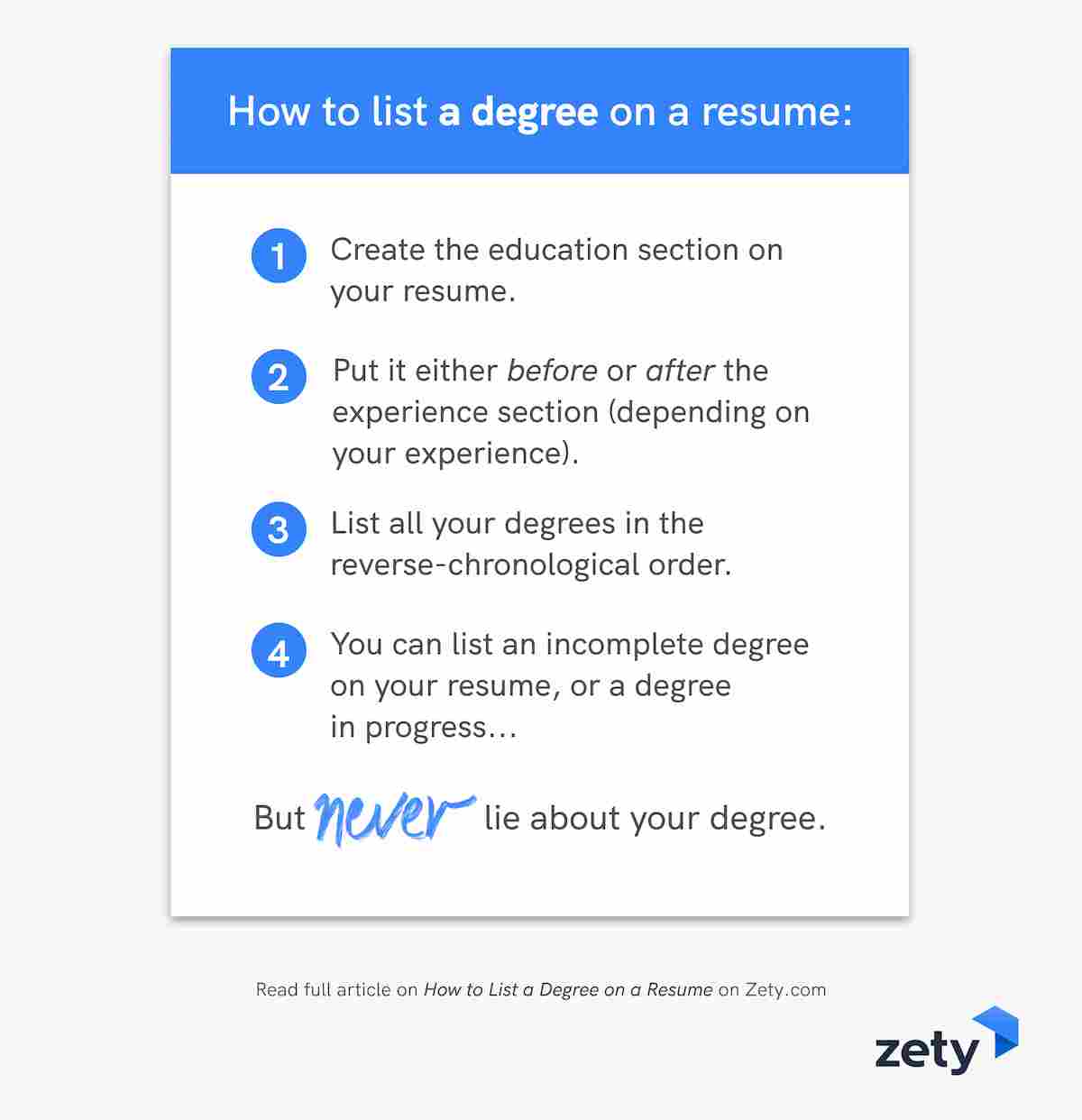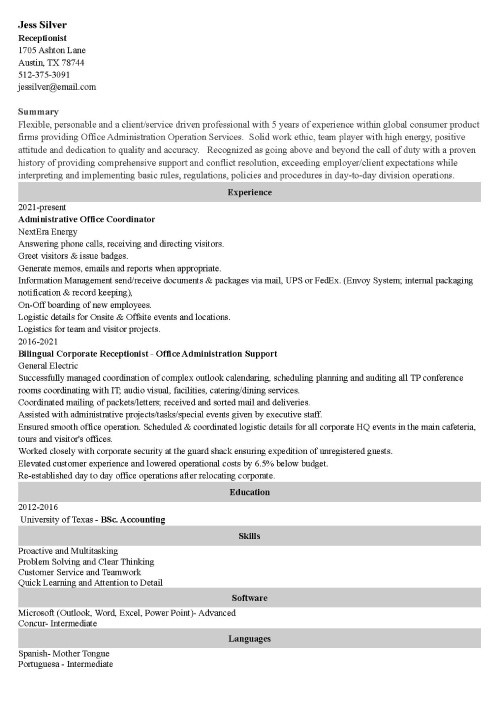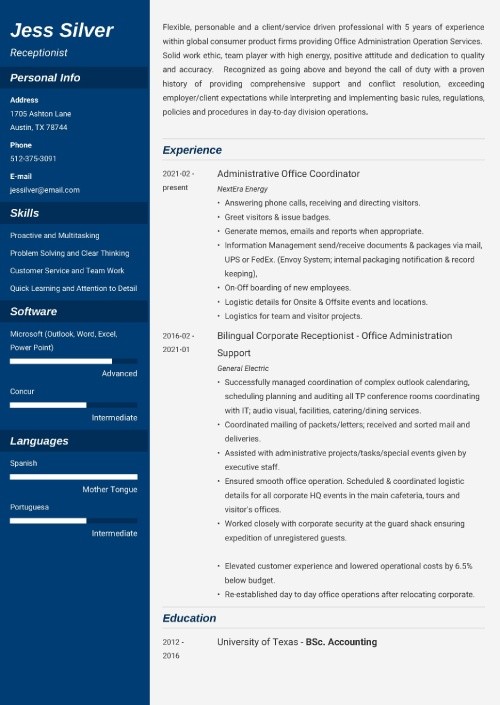
How to List a Degree on a Resume (Associate, Bachelor’s, MA)
Listing a degree on a resume is part and parcel of resume writing. We’ll show you how to get it right regardless of the type of degree you’d like to put on your resume.
Putting your degree on a resume may feel like a no-brainer—but that’s until you actually start doing it.
All of a sudden, a flurry of unexpected questions appears: How to list my associate’s degree on a resume? What if I’m currently pursuing a degree? How to write a bachelor's degree on a resume? Do I use periods in the abbreviation? We got you.
This article will show you:
- All you need to know on how to write a degree on a resume.
- Examples of how to list your academic degree on a resume.
- Tips on common questions about writing a degree on a resume.
Want to save time and have your resume ready in 5 minutes? Try our resume builder. It’s fast and easy to use. Plus, you’ll get ready-made content to add with one click. See 20+ resume templates and create your resume here.
Sample resume made with our builder—See more resume examples here.
Here are some other articles that you might be interested in:
- How to Make a Resume
- What to Include in a Resume
- How to Put Your Education on a Resume
- College Graduate Resume
- College Student Resume
- Undergraduate Resume
- Student Resume
- Entry-Level Resume
- Graduate School Resume
- High School Student Resume
- High School Graduate Resume
- MBA Application Resume
- Resume Examples for Teens
- Resume With No Experience
- Scholarship Resume
- Some College on Resume
- Certifications on Resume
- Expected Graduation on Resume
- Professional Resume Examples
1
How to List an Associate Degree on a Resume
An associate degree is an undergraduate degree awarded after two or three years of post-secondary education. It’s a degree that’s halfway through a GED qualification or high school diploma and a bachelor’s degree.
You should put your associate degree on a resume in a dedicated education section.
Depending on how much experience you have, the resume education section could either come before or after your experience resume section.
Here’s an example of how to write an associate degree on a resume:
Associate Degree on a Resume
2016–2017
Sandhills Community College, Pinehurst, NC
Associate in Arts in English
As a rule, you should spell out the full name of your degree rather than abbreviate it.
That said—
If you’re short of space on your resume, you’re free to abbreviate your degree. Just make sure it’s understandable to the recruiter. If in doubt, don’t abbreviate.
Here’s a list of several common ways to abbreviate an associate degree on a resume:
- AA (Associate in Arts)
- AAB (Associate of Applied Business)
- AAS (Associate in Applied Science)
- AAT (Associate of Arts in Teaching)
- ABA (Associate of Business Administration)
- AS (Associate in Science)
Pro Tip: Your college may call the degree either “Associate in” or “Associate of.” Make sure you use the correct preposition when listing your associate’s degree on a resume. Check out your college’s style guide to be 100 percent sure.
Remember:
Don’t use an apostrophe when you spell out your degree on a resume.
Your resume education section should read e.g. Associate of Applied Science, not Associate’s of Applied Science.

And one more thing—
If you’re making your first resume, you may want to add some extra information, such as relevant coursework on a resume.
2
How to Write a Bachelor's Degree on a Resume
A bachelor’s degree is an undergraduate degree you can earn after four (sometimes five) years of full-time study.
Just like any other degree, you should list your bachelor’s degree on a resume in a dedicated education section.
If you’re fresh out of school, you may want to put the education section above the experience section. Also, consider including additional details on your educational background, such as relevant coursework, or the GPA score.
Here’s an example of how to list a bachelor's degree on a resume:
Bachelor's Degree on a Resume
2013–2017
UCLA, Los Angeles, CA
Bachelor of Arts in English
It’s advisable to put the full name of your degree on a resume, but if you’re economizing on space, you can use an abbreviation instead.
Bachelors degrees on a resume are commonly abbreviated to:
- BA (Bachelor of Arts)
- BS (Bachelor of Science)
These two abbreviations are the most common in the US.
However, you may also come across other abbreviations, such as B.A., Bach. Sci., B.Sc., S.B., B.S., ScB, or BSc.
All of these abbreviations are correct, understandable, and refer to a bachelor of arts/science.
But apart from these types of bachelor degree on a resume, recruiters may come across other kinds of bachelor’s degrees:
- BJHum (Bachelor of Journalism and Humanities)
- BMPD (Bachelor of Media Production and Design)
- BMusA (Bachelor of Musical Arts)
- BPAPM (Bachelor of Public Affairs and Policy Management)
- BScFS (Bachelor of Science in Forensic Science)
If you’re applying for a position related to your field of study, chances are that even a less common abbreviation won’t take anyone by surprise.
But remember:
Always make sure your resume is as informative and clear as possible. If a recruiter doesn’t know what an abbreviation stands for they won’t google it. They’ll reject your application.
This is why it’s advisable to avoid abbreviating your bachelor’s degree on a resume.

Pro Tip: You can use periods or not (e.g. B.A. or BA) when you put the abbreviated name of your degree on a resume. Either spelling is correct.
And finally—
If you didn’t manage to finish your degree, you can still list it in your education section. Just make it clear how much of a degree you did manage to complete.
Here’s how to list an incomplete degree on a resume:
Incomplete Degree on a Resume
2012–2015
UCLA, Los Angeles, CA
Completed 50 credits toward BA in English
If your work experience isn’t impressive yet, use the education section to tell the recruiters a bit more about yourself. Consider adding information on your minor on a resume, or display your GPA on a resume.
When making a resume in our builder, drag & drop bullet points, skills, and auto-fill the boring stuff. Spell check? Check. Start building a professional resume template here for free.
When you’re done, Zety’s resume builder will score your resume and tell you exactly how to make it better.
3
How to List a Master's Degree on a Resume
A master’s degree is an academic degree awarded by a university or college. It usually takes two years to complete a master’s program, and having a bachelor’s degree is a prerequisite (most of the time).
Write a master’s degree on a resume in the education section.
Pro Tip: List your degrees on a resume in reverse-chronological order. In other words, put your most recent degree at the top, and follow it with the previously earned one(s).
Here’s an example of how to list a master’s degree on a resume:
Master’s Degree on a Resume
2015–2017
UCLA, Los Angeles, CA
Master of Arts in English
Just like in the case of all the other degrees, you can abbreviate your master’s degree on a resume.
Here’s what some typical abbreviations may look like:
- A.M., M.A., MA (Master of Arts)
- M.B.A., MBA (Master of Business Administration)
- M.E., ME, MEng, M.Eng. (Master of Engineering)
- M.Ed., MEd (Master of Education)
- M.S., MS, M.Sc., MSc (Master of Science)
- M.S.Met. (Master of Science in Metallurgical Engineering)
Remember: clarity and understandability are vital when listing a degree on a resume.
Plus—
If you decide to follow The Gregg Reference Manual and put periods in your degree (e.g. M.A.) do it consistently throughout the entire resume. If you prefer The Chicago Manual of Style’s recommendations, and decide not to use periods (e.g. MA), also be consistent.
Last but not least.
If you're currently pursuing a degree, you can still list it on your resume. The only thing you need to do is say when you’re expected to graduate.
Look at this example showing how to list a master’s degree in progress on a resume:
Master’s Degree in Progress on a Resume
UCLA, Los Angeles, CA
Master of Arts in Psychology
Expected graduation date: June 2019

Did you graduate with honors? Why not put cum laude on a resume?
Pro Tip: High schools issue diplomas. Technically, there’s no such thing as a high school degree on resume. Learn how to put high school education on a resume to avoid lying about your degree on resume.
Plus, a great cover letter that matches your resume will give you an advantage over other candidates. You can write it in our cover letter builder here. Here's what it may look like:
See more cover letter templates and start writing.
Key Takeaways

Here’s how to list a degree on a resume:
- Create the education section on your resume.
- Put it either before or after the experience section (depending on your experience).
- List all your degrees in the education section of your resume.
- Put your degrees on a resume in the reverse-chronological order.
- Consider adding extra information about your degree on a resume (e.g. GPA, Latin honors, coursework, etc.).
- Format the information on your degree on a resume consistently.
- You can list an incomplete degree on your resume, or a degree in progress. But never lie about your degree on a resume.
Do you have any questions about how to write your degree on a resume? Maybe you’ve got some advice you’d like to share with others? Give us a shout out in the comments below. We’d love to hear your voice.
Frequently Asked Questions about How to List a Degree on a Resume
How to list your degree on a resume?
There are several options for listing your education. You can choose from these resume sections:
- The mandatory education section of the resume.
- Additional sections that are optional.
Use the former for your relevant degrees, and the latter for certifications & licenses, extra training, conferences, etc. If you’re writing a chronological resume, start with the most recent ones. In a classic resume layout, the extra information on your resume comes at the very end.
To put ongoing education on a resume, or to list an online degree on a resume, use the same approach.
How to list a bachelor's degree on a resume?
For an entry-level resume: if you’re a recent graduate, feature the degree, university, dates, and key achievements on your resume (like publications or extracurricular activities). Don’t hesitate to mention making the Dean's List on your resume, too. A high GPA on a resume is another asset, so put Cum Laude on your resume, if applicable. However, don’t list a low/average GPA—it’s one of the resume don’ts.
For experienced candidates: if you chose the reverse chronological resume order, list your most recent degree first, then go backward. You don’t have to add extra details, just the name of the degree, school, and dates.
How to list master's degree on resume?
For the classic resume format (reverse-chronological), list your master’s degree first, followed by your bachelor’s degree.
The order of sections depends on whether you’d like to highlight your resume work experience or your education:
- If you have relevant experience, your Education section should follow the Work section.
- If not, you can switch these resume parts.
How to list an associate degree on a resume?
List it in your regular Education section, mentioning “Associate” in the name of the degree. You might list some relevant coursework on your resume if you don’t have a lot of professional experience yet. In general, a resume with no experience will benefit from relevant details about your academic successes.
If you need more tips, read our guide on how to make your resume stand out.
How to list an incomplete degree on a resume?
If you have a pending degree, or your degree is still in progress, mark the expected graduation date on your resume as you list the degree. However, if you changed course and have an unfinished college degree, you may need to give it a second thought.
Should you include all work experience on a resume? Definitely not, if you want to submit a truly targeted resume that’s tailored to the job. The same applies to your education. When you’re choosing what to include in a resume, only go with the information that’s relevant to the position, otherwise, it may undermine your application.
How to list a dual degree on a resume?
A dual degree is a great asset that will contribute to crafting a good resume that showcases your dedication and excellent time management skills. Start with the most relevant of the two degrees. You don’t need separate entries (the time frame and the university will be the same), but do write each degree in a separate line. Consider adding “dual degree” for clarity.
Note that a double degree is not the same as a minor, so be sure to read our guide on how to list a minor on your resume for that scenario.




![Freelance Work on a Resume [Freelancer Resume Examples]](https://cdn-images.zety.com/pages/freelance_work_on_resume_1.jpg?fit=crop&h=250&dpr=2)